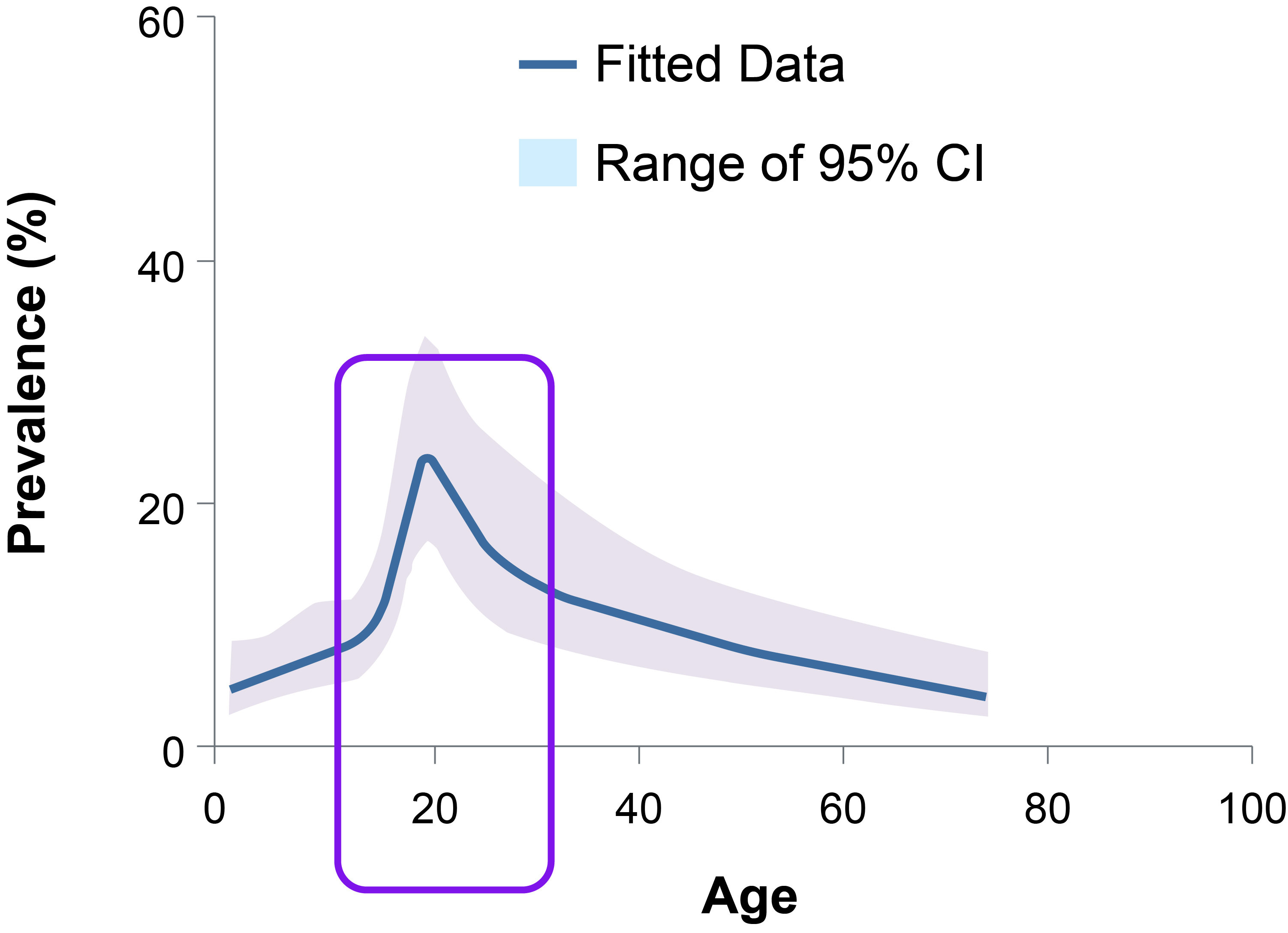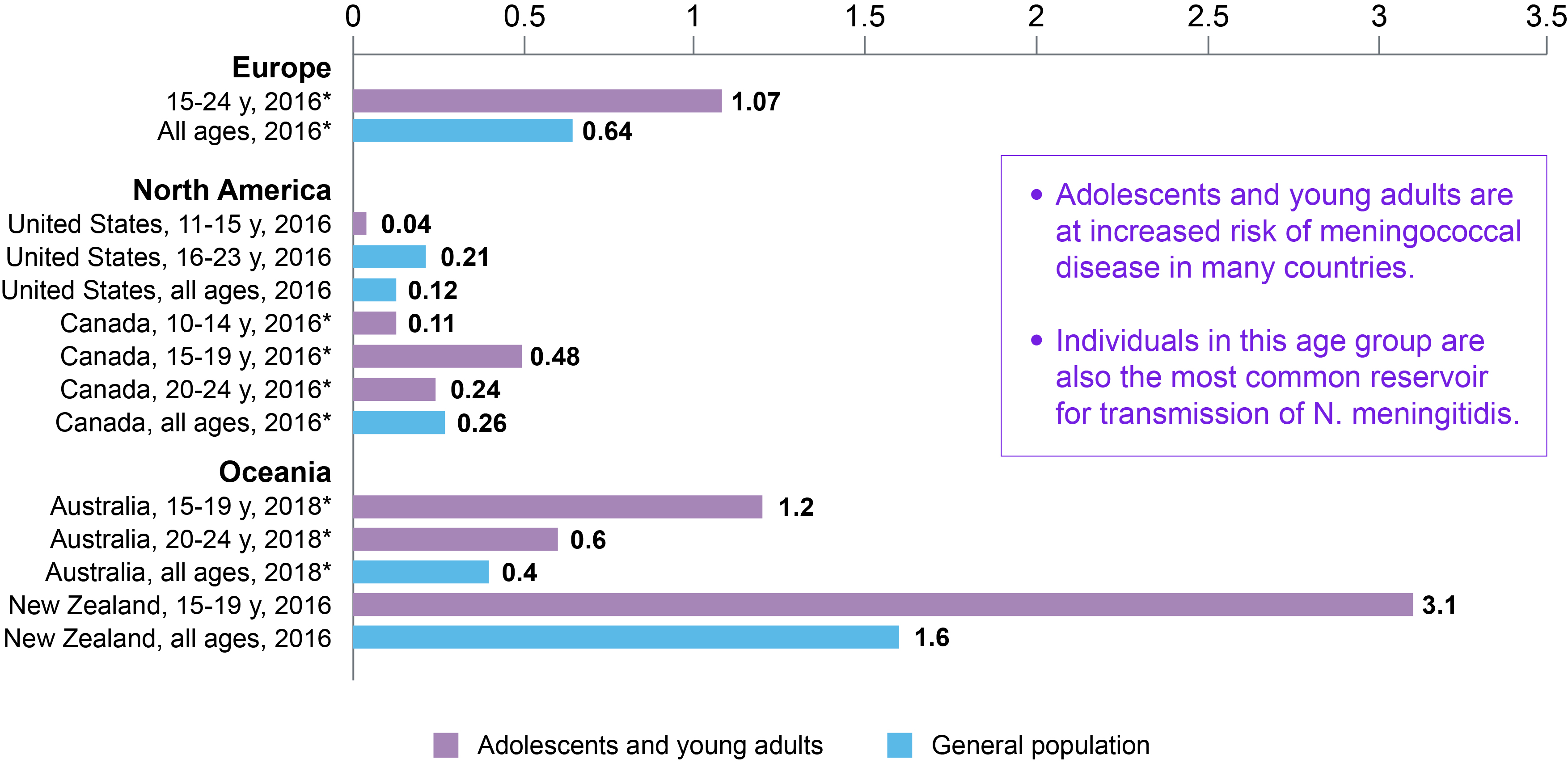IMD: Only with Neisseria meningitis, carriers could transmit the disease to both infants and elderly

Worldwide carriage rates are low during infancy & peak at 19 Years of age1
1. Carried asymptomatically in the URT of 8-25% of healthy individuals (<1% of carriers become symptomatic) 1
2. Carriage may be much higher in closed communities 1, University halls, Military camps, and Boarding schools
3. Pharyngeal carriage is a precondition for IMD
4. Young adults are the most common source of transmission to the community2
5. Up to 10% of adolescents and adults are asymptomatic transient carriers 3
Meta-analysis of 89 Studies in 28 Countries1

- Christensen. Lancet Infect Dis. 2010;10(12);
- Pelton. Pediatr Infect Dis J. 2009;28(4);
- CDC. In: Epidemiology and Prevention of Vaccine-Preventable Diseases. (The Pink Book) 13th ed. 2015
UK 2017: Risk of IMD in University Students in England

University students, particularly first years entering direct from school, are at higher risk for IMD than non-students
- Sema Mandal, Risk of invasive meningococcal disease in university students in England and optimal strategies for protection using MenACWY vaccine, Vaccine 35 (2017) 5814–5818
2019: Observational study of nasopharyngeal carriage of Neisseria meningitidis in applicants to a military academy in the Russian Federation
Design
Results: N. meningitidis was detected in:
❑ 6.2% of samples from Day 1,
❑ 7.7% of samples from Day 30
❑ 15.9% of samples from Day 60.
N.b. Of the 20 carriers identified at Day 30, 11 were included negative results at Day 1

Serogroup composition: Day 1, 40% serogroup B and 9% serogroup W dominant and Day 60, 58% serogroup W.
Conclusions:There was an increase in carriers of serogroup W in this population. Given recent increases in outbreaks attributed to serogroup W.
2019 Global incidence of IMD in adolescents by country
Incidence per 100,000 persons

- HUMAN VACCINES & IMMUNOTHERAPEUTICS, 2019, VOL. 15, NO. 2, 459–469 https://doi.org/10.1080/21645515.2018.1528831
2020: Meningococcal Carriage In Norwegian Teenagers
Method:
Results:

Prevalence of carriers of N. meningitidis by age (n = 2296; carriers of N. meningitidis n = 167).
- S. V. Watle et al, Epidemiol Infect. 2020; 148: e80. Published online 2020 Mar 31. doi: 10.1017/S0950268820000734
2021: The Burden of IMD in adolescents and adults in (MENA) Region Summary of studies for Neisseria meningitidis
| Kuwait |
Husain et al. [38] |
1987-2013 | National population-based surveillance data 293 cases reported |
Mean annual incidence: 0.5 per 100,000. Adults aged ≥ 20 years accounted for 26% of all cases; 30% of cases in individuals ages > 14 years.
| Saudi Arabia |
Mmeish et al. [39] |
1995-2011 | All IMD cases in the national surveillance data |
Mean annual incidence in the general population (per 100,00): 0.20 (1995-1999; before outbreak), 1.32-1.42 (2000-2001; outbreak), ≤ 0.06 (2002-2011; following MenACWY vaccination policy).
Mean age of cases (1995-2011): 25.8 years.
Most common serogroups (aged ≥ 15 years): W, 45%; A, 42%.
CFR: aged > 45 years, 32.57%; aged 15-45 years, 19,41%.
CFR case fatality rate, IMD invasive meningococcal disease, MenA meningococcal serogroup A, MenACWY quadrivalent meningococcal vaccine, MenB meningococcal serogroup B, MenW meningococcal serogroup W, OR odds ratio
- Infec Dis Ther (221) 10:663–685, https://doi.org/10.1007/s40121-021-00420-y
Epidemiology of meningitis in Al-Ain, United Arab Emirates, 2000—2005

Number of cases in adolescents' group

Causative agents of bacterial meningitis
- International Journal of Infectious Diseases (2007) 11, 309—312
MAT-BH-2200533 -V2-June-2022